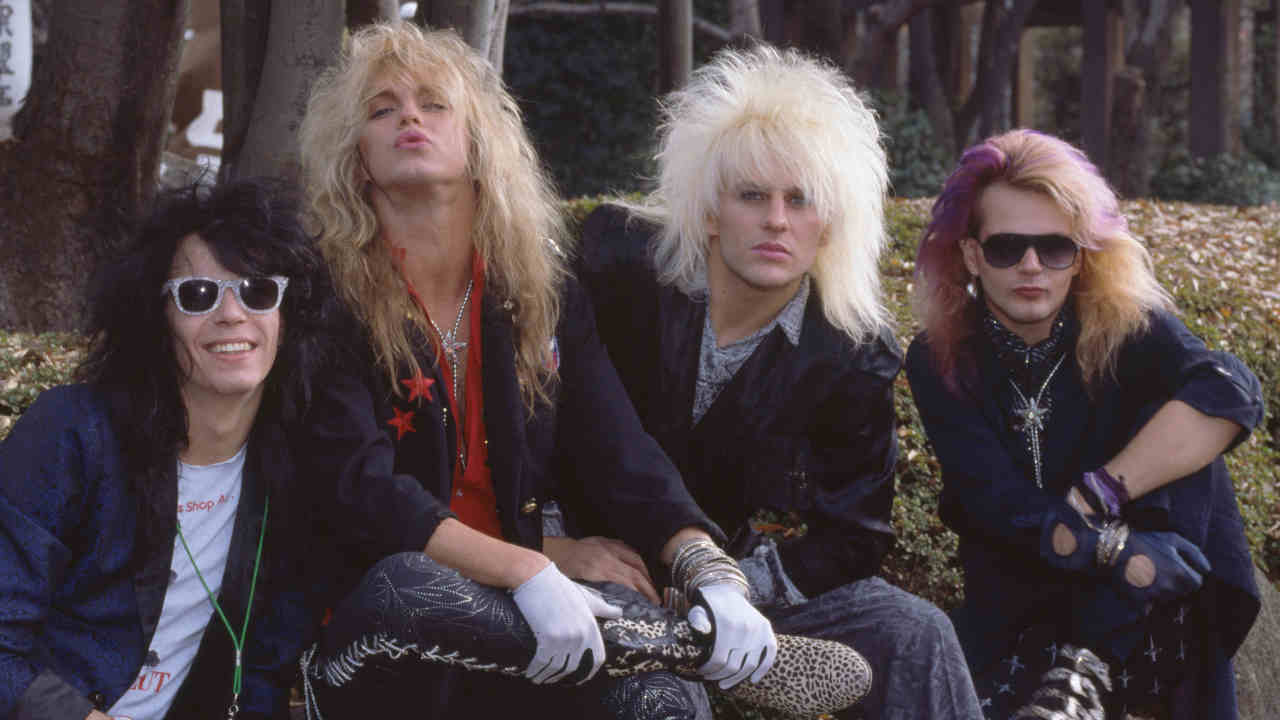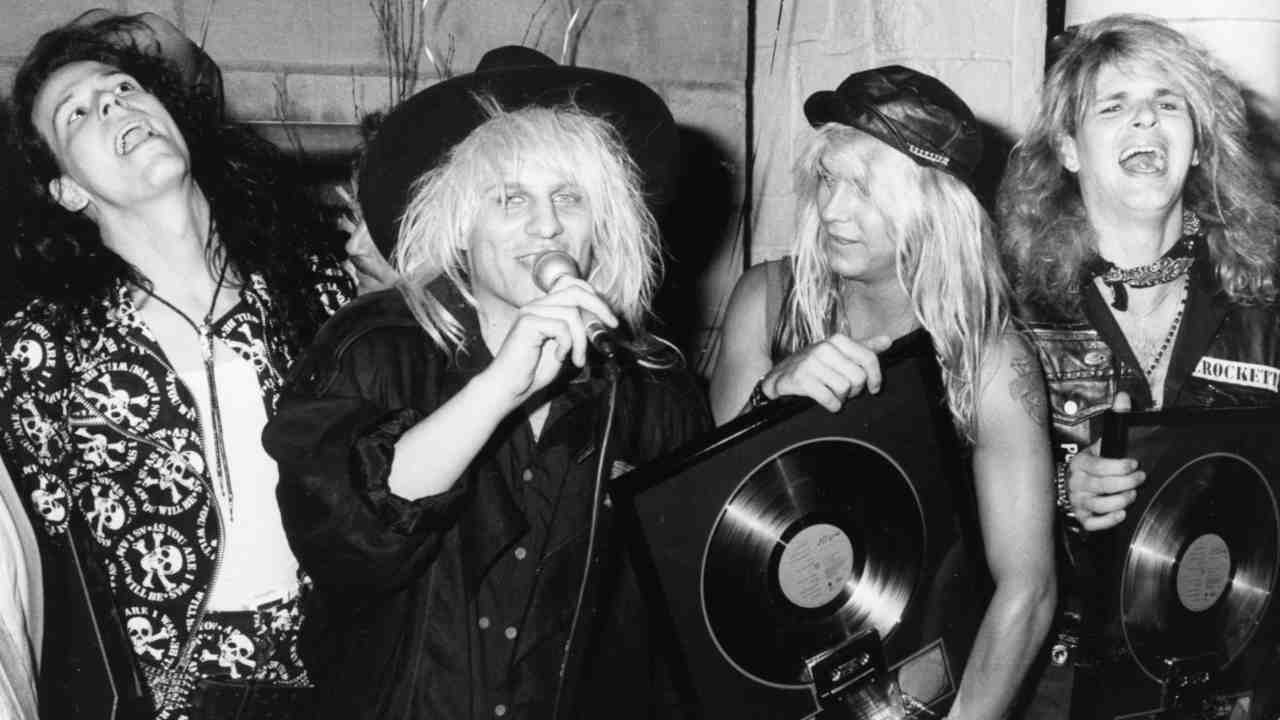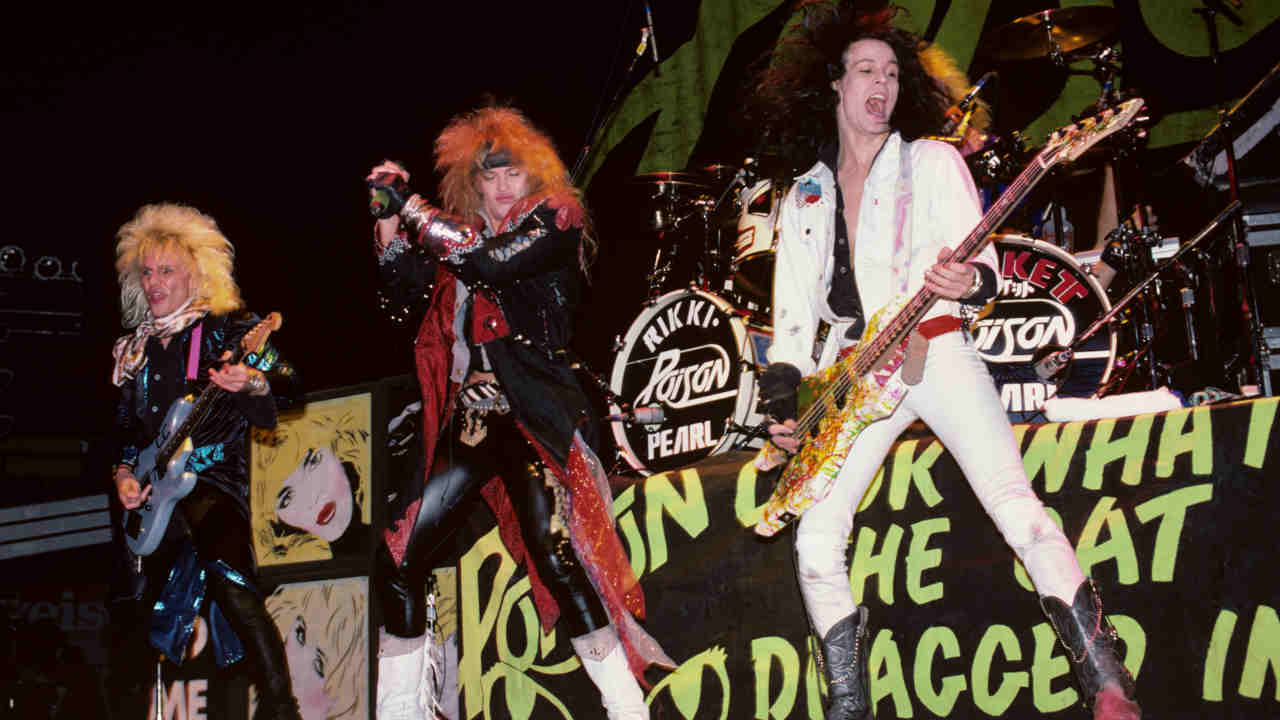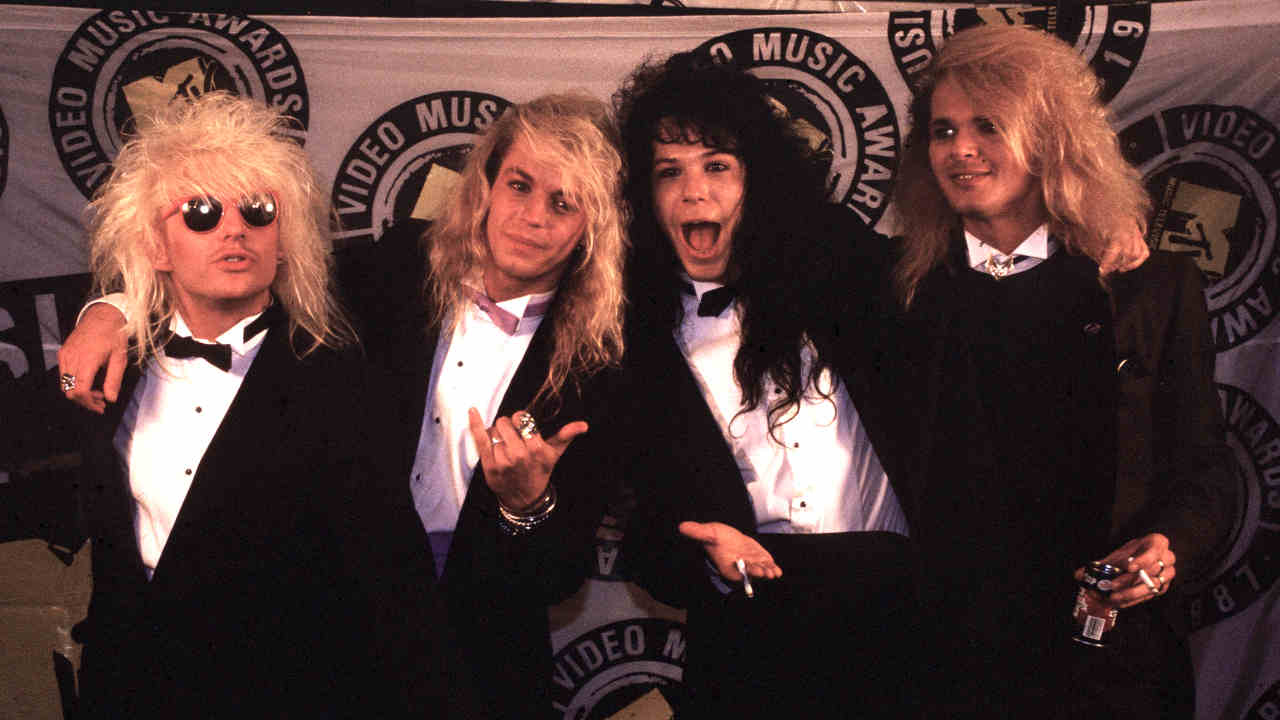
Poison were one of the most popular – and derided – bands to emerge from the Sunset Strip scene in the 80s, and their 1986 debut album Look What The Cat Dragged In remains a glam metal classic. In 2006, singer Bret Michaels and drummer Rikki Rokket looked back on their glory days.
The Hyatt hotel on Sunset Boulevard has a prime location in West Hollywood and several claims to fame. Led Zeppelin called it ‘the riot house’ when John Bonham drove his motorbikes from the underground car park up the ramp on to the mezzanine level. Rob Reiner used its rooftop pool as the setting for Spinal Tap’s end-of-tour party. In the 80s, Little Richard lived for a time in one of the suites on the top floor, accessible only to residents via a bespoke lift and special golden key.
One soft summer afternoon in 1990 the Hyatt was under siege for an entirely different reason. Pressed up against the toughened glass of the entrance, staring into its air-conditioned lobby, were scores, perhaps even hundreds of girls. They were screaming names so loudly that they were audible even within the moneyed vacuum of the ground-floor bar.
“Rikki!” they shrieked.
“Bret!”
“Bobby!”
“CC!”
“Omigod!” they yelled. “It’s Poison!”
The girls were right. Edging through a gathering that also included assorted members of Dio, Anthrax and Helloween, four men who looked rather like the women who were screaming at them got their first inkling of how hard it was going to be to reach the tour bus that would take them towards the Long Beach Arena and even more screaming women.
“Hey, Rikki,” someone shouted after some moments of this madness, “tough life, huh?”
Drummer Rikki Rockett ponders when asked if he remembers the scene from that day. “Hmmm. Yeah… maybe. That kind of stuff happened quite a lot. Do we still get girls screaming at us? Let me tell you, at a show last summer, this woman comes up to me and lifts her t-shirt right up! I’m lookin’ at her tits, man, and she says, ‘Rikki, can you sign my stretch marks?’ I’m like, ‘Huh? Sign your what?!’ And then she introduces me to this guy and says, ‘This is my husband and our little boy was conceived to Every Rose Has Its Thorn. You guys gave me these stretch marks, so the least you can do is sign them…’ I thought that was kinda cool, I really did.”
“Man, it wasn’t just America,” adds frontman Bret Michaels. “I remember being in England and going to the Marquee. I was in a limo with – you remember that girl Vanessa, used to do MTV? Vanessa Warwick, right? We’re doing this thing for Headbangers Ball. We’d been there a couple of days and we’re in this limo, me and Vanessa, with the cameraman and the sound guy, all of that stuff. And we pull up outside the Marquee and it’s just insane. There are people about 10-deep on the pavement there. We get the door open and man, that’s it. Me and Vanessa just get pulled right out. Some girl’s got me by the hair. Some other girl’s got Vanessa by the fuckin’ hair! I dunno if they think she’s in the band, she’s with me or what. Maybe they know who she is and just feel like grabbing her hair? I pull away and this chick’s got literally a handful of my hair. I’m bleeding. Vanessa and me fight our way back to the car – man, it’s only about 2ft away – and the cameraman’s not even got this on film! He’s lying on the floor of the limo with his hands over his head. I thought, ‘Damn, the least he can do is get this on film and make me look popular…’”

Primped, teased and wearing make-up the way only boys can, Poison enjoyed their little chunk of the American dream, because that’s what it was. In the summer of 1985, three of the four of them had given up on life as a Pennsylvanian bar band and driven west in an old Ford Pinto that wheezed its last just as they steered it up the Sunset Strip.
“We wanted it all, man,” Michaels says. “The girls, the fame, the money, the hit records… and you could only really do that in New York or Los Angeles. For us, New York wasn’t really different enough, you know? We were from the east. And the weather was much better in LA and the girls were wearing less, so that’s the one we chose.”
In 1985, LA was chock-full of kids with the same idea. Most of them ended up in West Hollywood. They rented cheap rooms on the side streets off the Strip, near big clubs like the Troubadour and the Roxy and the Whisky A Go Go. They shopped for booze and TV dinners at Rock’n’Roll Ralphs, the supermarket that stays open all night, and spent hours on the sidewalks and in parking lots outside showcases and gigs, handing out flyers for their bands. They placed small ads in the Recycler for new musicians to replace the ones who gave up and went home. They tried to find managers and agents and girls who would love them enough to pay for their lifestyle. They lived that way because that was the way that you made it. Ratt and Mötley Crüe had set the template. They had made it look so easy that everyone else thought they could do it too. It was an environment it which only the ingenious might prosper.
“I guess we had a kind of naive belief in ourselves,” says Michaels. “We knew, between myself, Rikki and Bobby [Dall, bassist], what we wanted the band to be: a combination of the glam look and the party sound. We thought music kind of sucked. It had no energy. We were young, and we did have the energy and we just wanted to be rock stars, man. We had this guitarist, Matt Smith, who came out with us but he didn’t stick around too long. He got his girlfriend pregnant. He was very cool about it. He said, ‘I am going to be a father and we are living like pigs. I can’t do this. I need to go get a job and support my family.’ And he was right. We were living like pigs. We lived behind a dry cleaner’s in a warehouse. It was a sad moment for us when he left.
“We held some auditions and the guy I really liked was Slash. This was before he was in Guns, obviously, but he had the same look back then, he was very cool. He had that kind of Rolling Stones-type cool that he still has. He came into our rehearsal room and he played every song we had, note perfect. He was very rock’n’roll.”
“And then this other guy showed up,” says Rockett. “And the dude’s got this fuckin’ hair everywhere and he’s like – and this is before he’s even plugged in – he’s like, ‘Man, I ain’t playing any of your songs, I’ve got a riff you can use. And the riff he’s got is Talk Dirty To Me…”
“I have to be honest, at the time I argued for Slash,” admits Michaels. “It was really strange. It came down to three people. One of them was CC [DeVille], one was Slash and one was this guy who had played with Joe Perry. Slash wanted to have duel guitar-player situations and we were not looking for that. CC came in with Talk Dirty To Me already written. Me and him didn’t get along from the start – Rikki and CC loved each other but Bobby and me couldn’t stand him. There was just something about him. We made the right decision for us and Slash but it’s been a fiery ride.”
“I think that Bret maybe felt that CC was a loose cannon,” adds Rockett, “but when we jammed, it was obvious to me that he was the one. Talk Dirty To Me was just so catchy I thought, ‘That’s a hit.If he can write songs like that, he should be in the band.’”
“So we all lived together,” Bret continues, “in a variety of places. There was one way out near South Central, one in a warehouse by the dry cleaners on Palm Grove Avenue – man, that was hot. We spent one Christmas in there. We got this little tree and we sat there ripping up our flyers and making them into decorations for the tree. In many ways those were my favourite days for the band because it was that all-for-one time. We felt like it was us against the world, which sounds fuckin’ corny but it’s how it was.”
They weren’t entirely alone. There was an unofficial system in place, a code of mutual dependence. Bands got girls and girls paid a price for admission.
“Sure, we’d have girls buying our groceries, stuff like that,” says Bobby Dall. “If they wanted to come hang out with the band and stay over at the house then, yeah, that’s what it took. We were hungry. We’d get money from gigs but we used that to keep the band going. We needed to eat…”
Poison might have seemed like every other band on the Strip, hawking themselves around with flyers and big talk, but little things set them apart. They were not seduced by the lifestyle. Many were; merely arriving in LA fulfilled some kind of goal. For them, living the dream consisted mainly of telling people that they were living it. Michaels was consciously trying to steer clear of this pack from his first day in town.
“I went to get some flyers done and the paper’s too expensive. So I’m trying to cut a deal with the guy and he takes me into the back room and says, ‘That’s all we got’ and it was this day-glo green stuff. He said he couldn’t get rid of it. I said, ‘I’ll take it’. Because of that, our flyers were different to everyone else’s. People remembered us. We’d play shows to a few fans and we wouldn’t be blaming the club owner that not many people showed up. We’d re-book and play again and next time we’d have more people there, because we worked hard to get them there. I looked on it like a job, man. I wasn’t going to go back home. If we had to play a Top 40 set to get the crowd going or get the gig we’d do that – and then we’d throw in a few of our own tunes at the end.”
The Los Angeles of 1985 boasted some exotic sights. Blackie Lawless and his exploding codpiece were in residence at the Rainbow Bar & Grill. Randy from Odin bestrode Gazzarri’s, his butt cheeks busting free of his backless leather chaps. Mick Mars looked like a man dressed up as a woman dressed up as a man as he haunted the Troubadour. Those two tremendous old tarts Taime Downe and Riki Rachtman were plotting at the Cathouse, yet few of the city’s inhabitants offered the sheer girlish prettiness of Poison.
“I pictured us as a kind of a cross between the New York Dolls and Duran Duran,” says Rockett. “We were definitely glam and it came at a price. It actually provoked considerable hostility. I probably had five or six fights on the street. Guys couldn’t handle it. It was a challenge to them, especially as we would get girls or whatever.”
“We were consciously trying to push peoples’ buttons, push the limits,” agrees Michaels. “To me, the look and the music went together, it was designed to say something. Some people definitely couldn’t face that.”

Some record companies couldn’t face it either – or at least that was what they said. Poison went up and down the Strip handing out demos and getting nothing for their trouble.
“Capitol, who we ended up with and who we’ve been with for 20 years, rejected us at least twice, I think,” says Michaels. “They’d come up with all kinds of stuff; ‘You’re too extreme’ or whatever. We didn’t consider changing it. We felt that we were onto something.”
Most of the bands on the Strip were in a similar predicament. For the most part, they did little about it; they just hung around hoping that the world had got it wrong. Poison decided that it had. They resolved to put the world straight by recording an album themselves. It was an audacious move considering that they had no money, had never been in a professional studio and hadn’t yet written all of the songs that would appear on it.
“The whole reason we had Ric Browde produce it was because we didn’t really know how a professional studio worked,” says Michaels. “We were in this place called Music Grinder. We had enough money for about eight days initially, so that was it. We had to get it done. I’ll be honest, I never liked Ric Browde…”
Eight days extended into 12, taken as and when the band could afford to pay for them. Poison spent $23,000 making the record, money they’d scraped together from gigs and t-shirts. It was CC who found Browde. “Because,” Browde said later, “CC’s girlfriend at the time was actually married to my roommate – Herman Rarebell, the Scorpions’ drummer. I produced Poison as a favour to CC.”
The control room was full of controlling personalities, Michaels and Browde in particular.
“He irritated the fuck out of me,” says Michaels, “but he did kind of get the sound down. I knew what we should sound like but we’d never been in a full studio before, so that was the service he performed for us. In terms of the songs, they were ours. Browde has said that we just wanted to sound like a metal band but that’s patently ridiculous. Did we look like a fuckin’ metal band? We wanted the record to be the soundtrack to the best, most killer party you could go to. I figured it would be the kind of record that you could listen to when you’re getting ready for a night out and it would pump you up, make you feel good.”
Browde was less convinced. He recalled: “It didn’t help that the first night we started recording, Bobby, Bret, CC and I went to see this unsigned band at the Troubadour and they blew me away. I told Poison no matter how many records they sold, they would never be as good as this unsigned band, who were called Guns N’ Roses…”
Surprisingly, the Michaels-Browde feud didn’t erupt until the record was finished. There was one major row, which began when Browde demanded the band play Talk Dirty To Me as a slow song.
“There’s no way that’s a slow song,” says Michaels. “He said it should be slow and I’m like, ‘Just listen to it…’”
“We stuck to our guns and were proven right,” adds Rockett.
However they arrived at it, the eventual conclusion of the sessions was a heroically inconsequential confection of disposable glam metal. Poison’s lyrical concerns, such as they were, suggested a band manifesto of dumb ambition, ASBO behaviour and getting laid. They made Mötley Crüe sound like Yes. Despite, or perhaps because of this, Look What The Cat Dragged In was utterly fantastic, one of the records that would summarise a particular time and place almost perfectly.
Yet the music was only the half of it. The record came in a sleeve that would become as iconic and instructive to its followers as the songs that lay within. It proposed a code to live by: four headshots in which Poison had, as promised, pushed everything to the limit. The band resembled finalists at Crufts, so teased were their barnets, so cloyingly cute their expressions.
“We wanted to come out and be as outrageous as we could,” recalls Michaels. “We wanted to get noticed and stand out. We wanted to shock people, so we went as over the top as possible.”
“It was Athena Bass, Tommy Lee’s sister, who did that cover for us,” adds Rockett. “We couldn’t have made ourselves look that good. She was far too beautiful and clever for us at that time, too… She kind of knew everybody and was connected.”
The band licensed the album to Enigma and it began selling immediately. By the time they had reached 30,000 copies, Capitol decided that they could stomach Poison after all and signed them up, acquiring the rights to Look What The Cat Dragged In as part of the deal. The rest was simple: they made videos that looked as good as the album sleeve and had some hit singles: Cry Tough, Talk Dirty To Me, I Won’t Forget You. Poison sold 3 million records. Those throwaway songs became the soundtrack to a year’s-worth of Saturday nights.
“It was very disorientating, one of those things that people describe as being surreal,” says Michaels. “This really was surreal. I’d been in LA a few months and suddenly I walk down the street and people know me. You can feel quite exposed by that.”
Because the album appeared loose and, in the true sense of the word, effortless, everyone in LA felt they could do the same thing. Browde tried to repeat the trick with Faster Pussycat but it proved harder than expected.
“Look What The Cat Dragged In was really a glorified demo but what it had was energy and great songs,” says Michaels. “We’re still playing them, but Browde has trashed us. I don’t know why. He knows what went down, he knows what we did and what he did.” [Browde told the Metal Sludge website: “They hate me because of a quote I gave to Billboard magazine, a quote I still stand behind today, which was, ‘Poison are a triumph of image over substance’.”]
“The next two records were pretty big too, so that suggests it wasn’t really a fluke and that we kind of had something to do with it, doesn’t it?” points out Rockett.

Around that time Poison started getting trapped in hotels by screaming girls and attacked by over-zealous crowds. They did lots of other things too: drink, drugs, fights, splits, affairs, sex videos…
“CC was getting fucked up and I was drinking,” admits Michaels. “He’s high but I’m drunk. We were having rows; he slammed me, I slammed him. We kept having really stupid arguments – stuff like his guitar was too loud for me to hear myself sing… we just couldn’t get it straightened out. I called it our ‘substance egos’. We had just been on tour way too long. Everyone was paranoid and down and then Bobby bust his hand in a car accident and, all of a sudden, this thing that seemed so solid sort of fell apart. You know, even talking about it now, it seems so silly.”
Poison had become emblematic of a particular period of rock culture they were unable to escape. Things got so bad that Michaels began writing country songs and DeVille stood outside gigs wearing a sandwich board offering fans the chance to have a photo taken with him – for $2.
Then Poison fans got old and nostalgic. The records reminded them of first dates and first loves, of cheap thrills before real life took hold. The band regrouped and began touring each summer; crowds got bigger and bigger. In 2006, they’ll play to audiences of between 6,000 and 10,000 people a night, at 51 shows.
“It’s been awesome,” grins Michaels. “We get the children of our original fans at the shows now. They say stuff like, ‘I remember hearing your records when I was a kid.’ I just say, ‘Kid, I grew up writing them. And it was something, it really was…’”
Originally published in Classic Rock issue 96







